BIHAR:
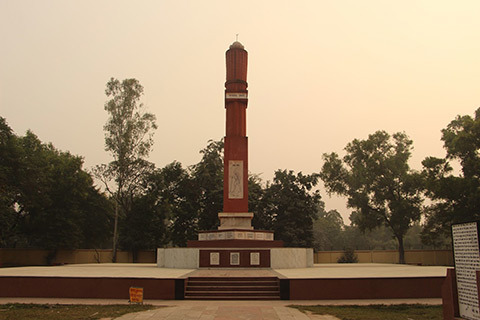
Mahatma Gandhi visited Bihar to help the farmers, who were forced to grow Indigo instead of food crops. It is in Champaran (in Motihari region) he launched his first Satyagrah (non-violent resistance).
Today one can see a
stone pillar erected in his memory and a
Gandhi museum, which holds photographs and relics of mass agitation in Champaran. There is also one park to commemorate the Satyagrah of Champaran-
Champaran Satyagraha Shatabdi Park.
Motihari, also has many other interesting sites for its visitors. One of the historically and religiously important sites is
Buddhist Stupa in Kesariya, which is believed to be one of the world's largest
Ashokan pillar.
One of the eleven
Gandhi museums can be found in Patna (capital of Bihar) as well, which showcases his role in helping people from Bihar in the freedom struggle.
WEST BENGAL:
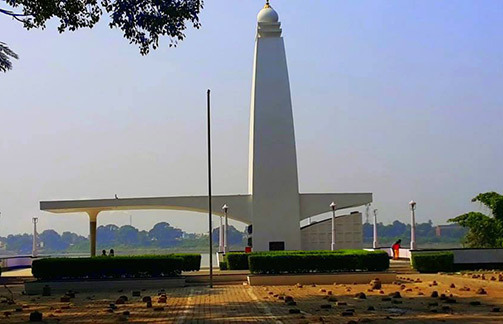
A place which saw two rebellions
(mutiny of 1824 and revolt by Mangal Pandey marking the beginning of freedom movement in India) against the British government,
Barrackpore (not too far away from the iconic city of Kolkata) has two very important memorials dedicated to Mahatma Gandhi -
Gandhi Museum, with rare books, photographs of freedom fighters, along with various information and artefacts and
Gandhi Ghat, with a lot of Murals describing his works.
The city, which was the first cantonment of Britishers in India, had been a house of many significant personalities involved in the Indian freedom movement.
Kolkata, which was the main hub of the British, attracted many visits of Mahatma Gandhi. Before his freedom struggle, his initial visit was to hotel
The Great Eastern (presently renamed as The Lalit Great Eastern), though today there are no traces to be found there. The second important place was
Albert hall, where he had a public meeting. He also visited Shantiniketan in his early years of the freedom movement.
Fun Fact: Do you know that title ‘Mahatma’ (a pious soul) was prefixed to his name at Shantiniketan by none other than the nobel prize winner Rabindranath Tagore.
MADURAI (TAMIL NADU):
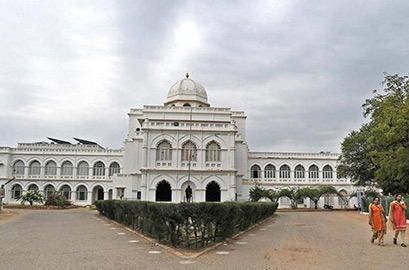
The temple city of Madurai was visited five times by Mahatma Gandhi in his lifetime. Here he was instrumental in getting unrestricted entry of the people belonging to all castes and creeds allowed into the iconic
Meenakshi Temple. When in Madurai, do not miss to see the
evening ceremony, which is a daily feature of this temple.
For the visual biography, one should visit
Gandhi Museum, which also possesses his personal belongings and a library with a vast collection of books on India's cultural background.
On an intrinsic city walk with us, one can visit the
flower market and explore the by lanes of the city. A little drive away in the vicinity of Madurai,
Pottery village can be an exciting place to know this age old tradition.
Fun Fact: Mahatma Gandhi’s common sight is a half-naked body wearing one-piece hand-woven cloth. Do you know that Madurai was the place where he denounced his western dress and chose this attire?
KANYAKUMARI (TAMIL NADU):
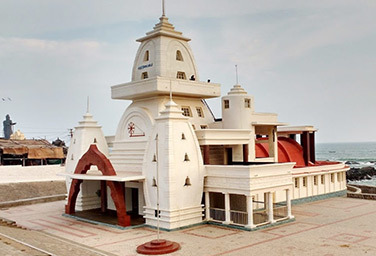
While it is also among the many other places he visited during his freedom struggle, what brought importance to this place in Mahatma Gandhi’s journey is that his ashes were immersed here at the point where the Arabian Sea, Indian Ocean, and Bay of Bengal meets.
In his memory, a temple style
Gandhi Mandapam has been built. Kanyakumari is also visited for
Kanyakumari Temple,
Thiruvalluvar statue, and
Vivekananda Rock Memorial.
A unique fact about Gandhi Mandapam: The ceiling of the building has an opening that has been planned in such a way that every year 02nd October (birth date of Mahatma Gandhi) the first sun rays falls on the very point where his ashes were kept for last glance before immersion.
MUMBAI (MAHARASHTRA):

Mumbai had seen many visits of Mahatma Gandhi. Even before the freedom struggle, he visited the city many times for his professional quest. However, his prolonged stay can be traced during the freedom struggle, when he staged political fasts and campaigns while staying in
Mani Bhawan. This home is still preserved with rooms as they were, and it is open to the public displaying his belongings and various works.
In Mumbai, he launched another famous movement, ‘Quit India’, and
August Kranti Maidan is the place that hosted this historical event. The vicinity is full of
colonial buildings, and a stroll around it with our experienced guides will give a chance to go back in to the past and admire the old architecture.
His aura was not confined to Mumbai only but can be felt in other parts of Maharashtra as well. An interactive museum in
Jalgon is one such wonder. Located around 60 Kms away from the UNESCO listed
Ajanta caves and housed in Gandhi Research institute, which is known as
Gandhi Teerth, the museum disseminates the works and life journey of Mahatma Gandhi using modern audio visual systems, touch screen, bio-scope, etc. Along with sound and light shows, one can also go through the collection of books and stamps available here.
FUN FACT: A small town in Maharashtra, which was renamed from Segaon to Sevagram served as his next residence, after he vowed not to return back in Sabarmati until India gets its freedom. This tiny village has a museum exhibiting artefacts from his life.
PUNE (MAHARASHTRA):
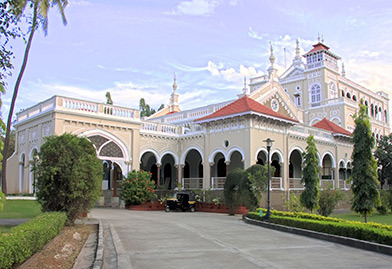
Jails were almost a second home to the freedom fighters and Mahatma Gandhi was not an exception. As a part of his freedom struggle movements, he was imprisoned and kept in a number of jails in different parts of the country, but Pune is the place where one can trace many of the important incidents of his life.
Yerwada Jail, (although not open for common tourists), has retained the cell where he was imprisoned, as a memorial. Today jail inmates are offered a course on his principles. While he went to jail many times for his peaceful protests, his last jail in 1942 had a special place.
He was house arrested along with his wife in the
Aga Khan Palace. Though it might have better amenities than a jail, the place turned out tragic for him as he lost his wife there. Her
memorial stone can be seen in the palace today.
The entire palace has been reserved as his memorial. Along with other possessions of Mahatma Gandhi, one can also see the room where he was confined.
Fun Fact: One can call it a tragic co-incident, as the man who assassinated Mahatma Gandhi also belonged to this land (Pune).
DELHI:
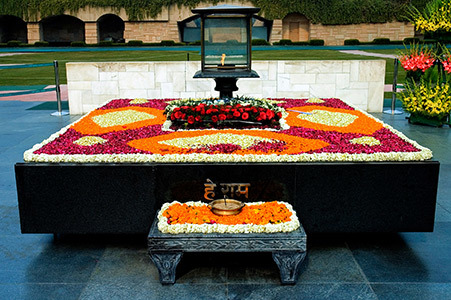
Delhi was the land where Mahatma Gandhi spent his last days of life. After a stay of around 144 days at Birla House, he was assassinated in its gardens while offering prayers on 30th January 1948. Today, this place has been preserved as his memorial and known as
Gandhi Smriti. While his belongings and other related things are on a display, the most interesting thing to see here is the path marked with footprints where Mahatma Gandhi walked his last steps, ending at the spot where he fell.
The place where his last rites were performed is
Rajghat, and one can see a memorial built of black stone here. There are two museums near it, which possess his clothes, a pocket watch, and one of the bullets shot at him.
Rajghat is very close to the
Chandni Chowk market, which is nothing less than an open gallery of colourful markets. The monumental city of Delhi is historically rich and has a lot to explore along with its UNESCO listed monuments.
A visit following the footsteps of Mahatma Gandhi could be a life changing for many. One could not imagine freedom without violence and he was the man who proved to the world that violence is not the solution to everything. He believed “An eye for an eye would leave the whole world blind.” The philosophy of this great soul was unique and that’s the reason his principles and teachings are still followed not only in India but in many countries across the globe, in his words
“In a gentle way, you can shake the world”.
Watch humility of Mahatma Gandhi in this short and vintage interview. We, at
Indo Asia Tours, are all about the handcrafted tours, memories, and moments you take out of your trip, and believe us, this escapade will be a life-changing one!



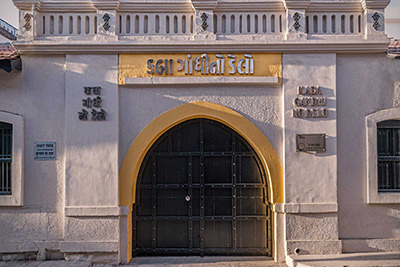 Rajkot served as a place of his second home, as the family moved here due to a change in his father’s job.
Rajkot served as a place of his second home, as the family moved here due to a change in his father’s job.
 While the above cities saw his childhood, Mahatma Gandhi's social or political journey started in Ahmedabad. He went to South Africa to study law, returned to this city after various life events and finally settled here. Sabarmati Ashram, where he stayed around 13 years is one of the city's major highlights today. It houses many structures within the complex:
While the above cities saw his childhood, Mahatma Gandhi's social or political journey started in Ahmedabad. He went to South Africa to study law, returned to this city after various life events and finally settled here. Sabarmati Ashram, where he stayed around 13 years is one of the city's major highlights today. It houses many structures within the complex:
 Do not forget to take back a miniature spinning wheel as a souvenir, as this spinning wheel became the symbol of revolution, and Khadi
(Handwoven and hand-spun cloth) was born. Even today, Khadi is common in traditional & ethnic dresses, and one can notice that it is the dress code of the majority of Indian politicians.
Do not forget to take back a miniature spinning wheel as a souvenir, as this spinning wheel became the symbol of revolution, and Khadi
(Handwoven and hand-spun cloth) was born. Even today, Khadi is common in traditional & ethnic dresses, and one can notice that it is the dress code of the majority of Indian politicians.
 Mahatma Gandhi visited Bihar to help the farmers, who were forced to grow Indigo instead of food crops. It is in Champaran (in Motihari region) he launched his first Satyagrah (non-violent resistance).
Mahatma Gandhi visited Bihar to help the farmers, who were forced to grow Indigo instead of food crops. It is in Champaran (in Motihari region) he launched his first Satyagrah (non-violent resistance).
 A place which saw two rebellions (mutiny of 1824 and revolt by Mangal Pandey marking the beginning of freedom movement in India) against the British government, Barrackpore (not too far away from the iconic city of Kolkata) has two very important memorials dedicated to Mahatma Gandhi - Gandhi Museum, with rare books, photographs of freedom fighters, along with various information and artefacts and Gandhi Ghat, with a lot of Murals describing his works.
A place which saw two rebellions (mutiny of 1824 and revolt by Mangal Pandey marking the beginning of freedom movement in India) against the British government, Barrackpore (not too far away from the iconic city of Kolkata) has two very important memorials dedicated to Mahatma Gandhi - Gandhi Museum, with rare books, photographs of freedom fighters, along with various information and artefacts and Gandhi Ghat, with a lot of Murals describing his works.
 The temple city of Madurai was visited five times by Mahatma Gandhi in his lifetime. Here he was instrumental in getting unrestricted entry of the people belonging to all castes and creeds allowed into the iconic Meenakshi Temple. When in Madurai, do not miss to see the evening ceremony, which is a daily feature of this temple.
The temple city of Madurai was visited five times by Mahatma Gandhi in his lifetime. Here he was instrumental in getting unrestricted entry of the people belonging to all castes and creeds allowed into the iconic Meenakshi Temple. When in Madurai, do not miss to see the evening ceremony, which is a daily feature of this temple.
 While it is also among the many other places he visited during his freedom struggle, what brought importance to this place in Mahatma Gandhi’s journey is that his ashes were immersed here at the point where the Arabian Sea, Indian Ocean, and Bay of Bengal meets.
While it is also among the many other places he visited during his freedom struggle, what brought importance to this place in Mahatma Gandhi’s journey is that his ashes were immersed here at the point where the Arabian Sea, Indian Ocean, and Bay of Bengal meets.
 Mumbai had seen many visits of Mahatma Gandhi. Even before the freedom struggle, he visited the city many times for his professional quest. However, his prolonged stay can be traced during the freedom struggle, when he staged political fasts and campaigns while staying in Mani Bhawan. This home is still preserved with rooms as they were, and it is open to the public displaying his belongings and various works.
Mumbai had seen many visits of Mahatma Gandhi. Even before the freedom struggle, he visited the city many times for his professional quest. However, his prolonged stay can be traced during the freedom struggle, when he staged political fasts and campaigns while staying in Mani Bhawan. This home is still preserved with rooms as they were, and it is open to the public displaying his belongings and various works.
 Jails were almost a second home to the freedom fighters and Mahatma Gandhi was not an exception. As a part of his freedom struggle movements, he was imprisoned and kept in a number of jails in different parts of the country, but Pune is the place where one can trace many of the important incidents of his life. Yerwada Jail, (although not open for common tourists), has retained the cell where he was imprisoned, as a memorial. Today jail inmates are offered a course on his principles. While he went to jail many times for his peaceful protests, his last jail in 1942 had a special place.
Jails were almost a second home to the freedom fighters and Mahatma Gandhi was not an exception. As a part of his freedom struggle movements, he was imprisoned and kept in a number of jails in different parts of the country, but Pune is the place where one can trace many of the important incidents of his life. Yerwada Jail, (although not open for common tourists), has retained the cell where he was imprisoned, as a memorial. Today jail inmates are offered a course on his principles. While he went to jail many times for his peaceful protests, his last jail in 1942 had a special place.
 Delhi was the land where Mahatma Gandhi spent his last days of life. After a stay of around 144 days at Birla House, he was assassinated in its gardens while offering prayers on 30th January 1948. Today, this place has been preserved as his memorial and known as Gandhi Smriti. While his belongings and other related things are on a display, the most interesting thing to see here is the path marked with footprints where Mahatma Gandhi walked his last steps, ending at the spot where he fell.
Delhi was the land where Mahatma Gandhi spent his last days of life. After a stay of around 144 days at Birla House, he was assassinated in its gardens while offering prayers on 30th January 1948. Today, this place has been preserved as his memorial and known as Gandhi Smriti. While his belongings and other related things are on a display, the most interesting thing to see here is the path marked with footprints where Mahatma Gandhi walked his last steps, ending at the spot where he fell.
 Thank you, patrons, for reposing faith in our destinations and enquiring for customised virtual destination awareness training programs. We are proud to conduct them successfully so far and are looking forward to hold similar virtual destination awareness training programs for your team or yourself or a virtual tour for your clients. Let us know the destination of your interest along with your convenient date / time and we will be happy to set up a program for you.
Thank you, patrons, for reposing faith in our destinations and enquiring for customised virtual destination awareness training programs. We are proud to conduct them successfully so far and are looking forward to hold similar virtual destination awareness training programs for your team or yourself or a virtual tour for your clients. Let us know the destination of your interest along with your convenient date / time and we will be happy to set up a program for you.


